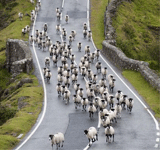| News Analysis: Supply-side reform key to China's agriculture upgrade | |||||||||||
|
|||||||||||
//english.dbw.cn 2016-02-01 15:43:53 |
|||||||||||
China is set to roll out supply-side reform measures to modernize agriculture, as featured in the annual "Number One Central Document" released on Wednesday. This year marks the 13th time in the new century such a document, by the Communist Party of China Central Committee and the State Council, has focused on the issues of agriculture, rural development and farmers, which carries new hope for thousands of millions of farmers in China. Upholding an innovative, coordinated, green, open and shared development concept, the central authorities have called for faster transformation of agricultural models to ensure the society becomes moderately prosperous. The 12th Five-year Plan period has witnessed steady and fast growth in rural residents' income, narrowing rural-urban gap, and a gradual upgrade of agriculture. After years of bumper harvests, China no longer struggles with food shortages, but structural problems remain. The oversupply of corn and shortage of soybean, for example, indicates an imbalance between supply and demand. High production cost as well as ineffective allocation of resources adds to the burden. This is exactly where structural reform should come in. At its core, supply-side reform requires a market-oriented system where resource allocation will be optimized and demands will be better met. To be more specific, China needs to diversify its supply of agricultural products, create more trusted brands, reduce cost through scale management, and explore innovative business models such as combining production with tourism. China also needs to improve the quality of its farmland by cultivating it in an environmentally-friendly manner, ensuring it will be able to withstand floods and droughts. Training for professional farmers, increased investment in technology and diverse business entities and models will help increase the pace of change. The bottom line for reform is to ensure food security. To this end,a stable growth in grain output should be maintained to make it at least self-sufficient and less dependent on foreign imports. Food production structure must meet diverse consumption demand with enterprises encouraged to "go overseas" to balance exports and imports. Furthermore, policies and technological support should be improved to protect farming resources and raise efficiency in using them, preventing the resources from being tapped excessively and extensively, and prevent further pollution in agricultural production. Related: Chinese-run farms showcase modern agriculture in Angola LUANDA, Dec. 18 Xinhua -- Two farms run by China's Citic company are serving as a showcase of modern agriculture in Angola, said Liu Guigen, general manager of the farming development program of Citic Africa. Black Rock in Angola's central Malanje province is one of the two 10,000-hectare farms Citic is developing in Angola, with currently 3,000 hectares of corn and 1,000 hectares of beans planted. Full story China invests big in modern agriculture BEIJING, Dec. 1 (Xinhua) -- China spent 20.36 billion yuan (3.2 billion U.S. dollars) in 2015 developing modern agriculture, underscoring the country's continued efforts in deepening rural reform, the Ministry of Finance said on Tuesday. The funds were used to support leading industries with local characteristics in rural areas, promote the moderate scale management of land and strengthen adjustment of the agricultural structure, said the ministry. Full story |
|||||||||||
| Author: Source:xinhua Editor:Yang Fan |
|||||||||||
 中文简体
中文简体










